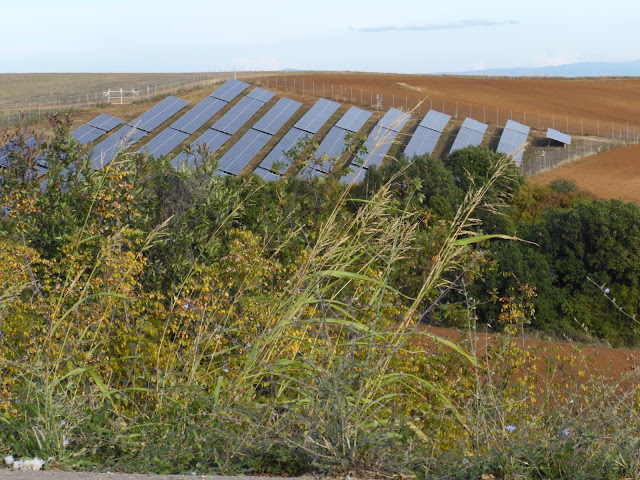I guess, unless you'd seen the surrounding countryside, you would not realize how 'out of character' this rocky outcrop is. Surrounded by Rolling hills, nicely rounded on top, from a distance this one looked like it had a man-made fortress/old castle on it. Closer up it looks like an eroded volcanic plug. We know Greece is close to the activity in a geological sense, we had a good wobble last Friday, and there are a few places the earth's heat leaks out at the surface (the hot beach on Evia being my personal favourite). Methana (the top of which we can see from our balcony) is another, and we encountered a couple of other minor examples in our travels. So it should come as no surprise that there are features that looks like the remains of old volcanoes.
Here's the question - some of the bushes in the foreground had these 'berries' on them. What are they? F reckons they look like sloes. She tasted one and said that although it has a single 'stone' in the middle like a sloe, it didn't taste as nasty as a sloe (fruit of blackthorn in England). Anyway in England sloes grow near the coast. We noticed these northwest of Serres, and again around Amyntaio. Can she make 'sloe gin' with them?
Whatever you are doing this week - stay safe.
This must have been the last unharvested crop of sunflowers in Greece by the time we were traveling in late October. The petals have all gone but they were still colourful in the landscape. We saw these the day we went to visit the bears.
Speaking of bears, we found out during the winery tour that bears have very discerning tastes. The winery concerned could not make much merlot because the bears kept eating the merlot grapes. Apparently they much prefer merlot to any other kind. I expect bears are not silly; if there are no merlot grapes they probably eat the other kinds too.
There is a lot of this kind of farming in Greece now too - no problem with being on bear menus, but I expect bears could none-the-less do a lot of damage if they got into one of these farms. They like rubbing themselves on things.






Hari OM
ReplyDeleteCrikey, Tigger... F tasting unknown berries? Braver than me! At least it is not Belladonna, this much I know... could it be a variety of huckleberry? Or maybe it is just a sloe, adapted to different conditions? I am just glad F survived to bring you home!!! Hugs and whiskeries, YAM-aunty xxx
Bite, spit, wait. I'm not sure how long you wait, but she had no adverse affects (that could be attributed to blue fruit) then or afterwards. Which raises another interesting question that we might save for a blog - about how cultures develop techniques for processing to an edible standard, plant material that would in all other circumstances kill them - and why they would even want to after the first cohort of testers died.
ReplyDeleteTapioca (raw cassava) comes to mind, karaka berries in NZ, and the Australian aboriginals in Queensland have an item on this list as well (can't recall what it is).
Hari OM
DeleteYes, it is interesting... hunger drives folk to all sorts I suppose! Yxx
I didn't know Greece had bears so that was something interesting to find out.
ReplyDeleteI also have wondered several times how people discovered how to make poisonous products into edible foods, as surely some would have died in the process. I hope you get to positively identify those berries.
Oh. Your brave tasting berries
ReplyDeleteThe big earthquake happened off the coast of the island my family come from. And we have close relatives who live there.
Very scary
Glad your ok
Reasonably plant savvy helps. We hope your family and their homes and businesses are all safe. It was only a prolonged wobble here in Piraeus, but did a lot of destruction in Turkey. It must have been pretty scary on Samos.
Delete